Si buscas
hosting web,
dominios web,
correos empresariales o
crear páginas web gratis,
ingresa a
PaginaMX
Por otro lado, si buscas crear códigos qr online ingresa al Creador de Códigos QR más potente que existe



Como señala Kruger (2000), la Sociedad del Conocimiento se caracteriza por tres tendencias: el uso intensivo de tecnologías de información y comunicación en todos los ámbitos sociales, la globalización de los procesos económicos y la emergencia de una civilización científicotecnológica. Ello entronca con los trabajos de Pérez (2004) en los que identifica cinco rasgos básicos de la sociedad del conocimiento:
- la producción intensa de conocimientos;
- su transmisión mediante la educación y la formación;
- utilización de capital humano en las actividades productivas;
- la difusión acelerada de la información a través de las TIC y sus redes;
- la explotación económica de los conocimientos mediante la innovación, sobre todo en los sectores productivos de mayor contenido tecnológico.
Por nuestra parte, en concordancia con las ideas expuestas en la tesis doctoral de Morales de Pérez (2014), en un mundo globalizado la educación debe integrar, la problemática ambiental las perspectivas de sostenibilidad, la justicia y la equidad, los problemas de pobreza, salud y alimentación, en fin una serie de aspectos para el bien común, y si se hace en estos términos ya no se hablaría de globalización sino de planetariedad, donde la educación y sobre todo la educación superior estaría al servicio del bienestar colectivo.
What is Reflux?
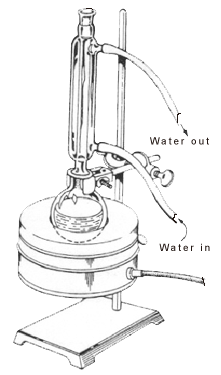
Many organic chemical reactions take very long to complete, and in order to speed up these reactions, heat is applied. Organic compounds are often volatile with high vapour pressures and low boiling points. When heated to a certain extent, they will become flammable and result in explosions. Thus, the application of heat must be done in a specific way to overcome the issue of evaporating too much solvent and drying the reaction vessel.
Reflux involves heating the chemical reaction for a specific amount of time, while continually cooling the vapour produced back into liquid form, using a condenser. The vapours produced above the reaction continually undergo condensation, returning to the flask as a condensate. This way, it guarantees that the temperature of the reaction remains constant.
The reactants for reflux experiments can be solid and liquid, or both liquids. The temperature at which the reaction is heated depends on the boiling points of the solvents and also the reflux ring (see below).
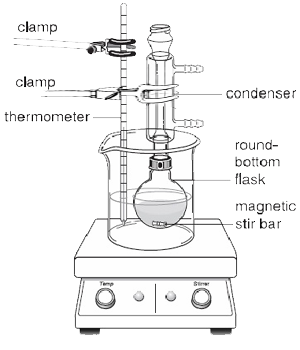
If the reactants added to the Round-Bottom Flask is not too viscous, a magnetic stir bar can be employed to prevent violent bumping of the boiling liquid and ensure even heating. As shown in figure 2, a hot plate should be used in place of a heating mantle when a magnetic stir bar is used because it contains a magnetic stirrer allowing the bar to be spun automatically while the reflux is taking place
The condenser is always completely filled with water to ensure efficient cooling. The vapours, which are given off from the liquid reaction mixture, change from gas phase back to liquid phase due to heat loss. This then causes the liquid mixture to fall back into the round bottom flask.
During the reaction, a part of the solvent travels up the condenser tube before condensing back into the flask. Above this point, the inner jacket of the condenser will appear dry. Below this point, the solvent flows back into the flask. The boundary between these two portions is the reflux ring. The temperature of the reaction must be set so that the reflux ring should only be one-third to half way up the condenser.
To know that boiling point has been reached, bubbles of vapour are produced inside the liquid. If the heating rate is turned up, the temperature of the reactants does not change, but the rate at which the boiling liquid changes into vapour form increases. This increase is caused by the increased supply of energy that facilitates more liquid molecules into overcoming their intermolecular interactions to enter the gas phase.
When a mixture of two or more volatile compounds is heated, the total vapour pressure (PT) of the mixture equals the sum of the vapour pressures of compound 1 and 2 (P1 and P2) in the mixture. The magnitude of the vapour pressure exerted by each compound is determined by the vapour pressure of that compound (P0) and the mole fractions of both compounds 1 and 2 present in the mixture (X1 and X2).
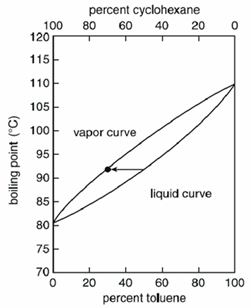
For an ideal two-compound solution, the solution vapour pressure is expressed by Raoult’s Law, shown in the equation below:
PT = X1P10 + X2P20 [1]
Depending on the mixture, the temperature boils variably. Homogenous mixtures boil at a temperature between the boiling points of the pure compounds, but the exact value depends on the amount (mass or volume) of each compounds.
For example, a liquid mixture when boiled will yield a vapour that will contain a larger percent of the more volatile compound. In a mixture of cyclohexane and toluene, cyclohexane is more volatile between the two and a liquid composed of 50 percent cyclohexane and 50 percent toluene would boil at 90°C and yield a vapour composed of 70 percent cyclohexane and 30 percent toluene.
When it comes to separating compounds a common method that is used in organic chemistry is distillation which separates compounds based on differences in boiling points.
In more sophisticated experiments, reflux and distillation can be carried out at the same time. For example, while a reaction is refluxing, a microscale distillation can be carried out using specialized equipment. Microscale distillation is to shorten the distillation path to reduce the chance for material loss in the process.
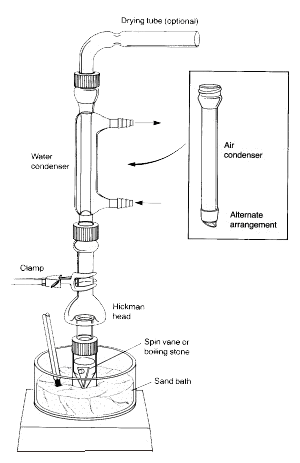 |
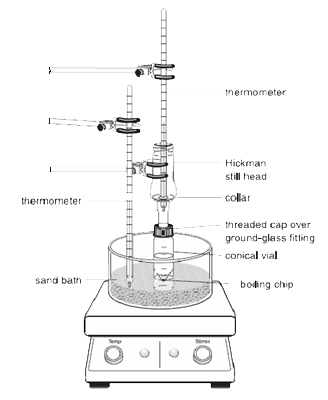 |
Sidenote: The vapours of the heated liquid rise upward and cool to condense on either the inside walls of the Hickman head or on the walls of the condenser.
The liquid that drains downward collects in the circular well at the bottom of the still.
1. The conical vial should be securely attached to the Hickman distillation head and the air condenser using the compression cap and the metal clamp. All pieces should have a ground-glass joint and fit together well such that no major leaks occur.
2. The spin vane should be placed in the conical vial and be pointed downward. The flat septum and the small compression cap are used to close the side port of the Hickman head. The entire setup is placed in the appropriate hole in the Al-block or sand bath and centered on the hotplate before starting to stir (otherwise the spin vane will flip over and rotate improperly).
3. The Hickman head and the air condenser have to be cooled with a wet paper towel. The heat source should be set so that the compound of interest distils over slowly.
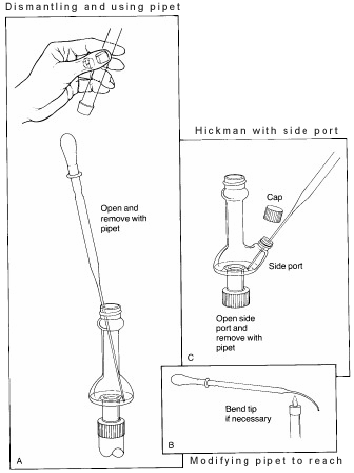
In the above set up, the Hickman Distillation Head acts as both an air condenser and a condensate collection vessel for simple or fractional distillations. The Hickman head can be separated into two types: ported and unported.
It is easier to collect fractions with the ported Hickman head. To do so the port should be opened to remove the liquid in the well with a Pasteur pipet (see 'C' in Figure 3).
For the unported Hickman head, the Pasteur pipet is used to draw the liquid out from the top. (see ‘A’).
If a condenser or internal thermometer is used, the distilling apparatus must be partially disassembled in order to do this. In some stills the inner diameter of the head is so small that it is difficult to reach in at an angle with the pipet and make contact with the liquid. To solve this issue, the tip of the pipet should be bent slightly in a flame.
Once removed, the liquid is transferred to a small vial and capped with a Teflon-sealed cap. If there is more than one volatile compound in the vial, it will be necessary to start with low heat to distill the lower boiling compound first. This way, compounds with a difference of boiling point of at least 50 oC can be separated relatively cleanly.
In the end, a few words of advice:
1. The conical vial should not be more than half filled in order to leave enough room for the liquid to boil. Otherwise the solution will spill out or over when it starts to boil.
2. A good seal between the joints minimizes the loss of target compound during the distillation. It also prevents dripping of a compound onto the hotplate, and a possible fire accident.
3. An appropriate temperature setting has to be used. Often times, a water or oil bath is used for better temperature control. If a heating mantle is used as heat source, it has to be plugged into a variable power control.
PENSAMIENTO

REFLUJO DEL PENSAMIENTO
Creó con sus ficciones un universo propio, un compendio asombroso de conjeturas, espejos, laberintos, paradojas… Obra imprescindible de la literatura contemporánea, sus cuentos pertenecen a la categoría de las páginas antológicas. Utiliza un singular estilo literario basado en la interpretación de conceptos como los de tiempo, espacio, destino o realidad. La simbología que utiliza remite a los autores que más le influencian -William Shakespeare, Thomas De Quincey, Rudyard Kipling o Joseph Conrad-. A lo largo de toda su producción creó un mundo fantástico, metafísico y totalmente subjetivo. Su obra, exigente con el lector y de no fácil comprensión, ha despertado la admiración de numerosos escritores y críticos literarios de todo el mundo. Describiendo su producción literaria, el propio autor escribió: “No soy ni un pensador ni un moralista, sino sencillamente un hombre de letras que refleja en sus escritos su propia confusión y el respetado sistema de confusiones que llamamos filosofía, en forma de literatura”. Es Jorge Luis Borges.

Ambos nacidos en el seno de la patria argentina, ambos escritores y cuentistas. Son dos representantes del género quienes descubrieron con su pluma mundos inmediatos y desmenuzaron las posibilidades del ser que habitan en un relato corto. Cortázar y Borges legaron en su producción literaria joyas talladas como cuentos: narraciones breves que abordan temas universales desde la intimidad de cada autor.
Dejamos 100 cuentos de Julio Cortázar y Jorge Luis Borges que fueron recopilados y publicados en el sitio Lecturas Indispensables.
Estos escritos se han convertido en clásicos del relato corto y forman parte de las páginas de otros volúmenes o antologías de cuentos memorables:
Cortázar
Bestiario (1951)
1. Casa tomada
2. Carta a una señorita en París
3. Lejana
4. Ómnibus
5. Cefalea
6. Circe
7. Las puertas del cielo
8. Bestiario
Final del juego (1956)
9. Continuidad de los parques
10. No se culpe a nadie
11. El río
12. Los venenos
13. La puerta condenada
14. Las ménades
15. El ídolo de las Cícladas
16. Una flor amarilla
17. Sobremesa
18. La banda
19. Los amigos
20. El móvil
21. Torito
22. Relato con un fondo de agua
23. Después del almuerzo
24. Axolotl
25. La noche boca arriba
26. Final del juego
Las armas secretas (1959)
27. Cartas de mamá
28. Los buenos servicios
29. Las babas del diablo
30. El perseguidor
31. Las armas secretas
Todos los fuegos el fuego (1966)
32. La autopista del sur
33. La salud de los enfermos
34. Reunión
35. La señorita Cora
36. La isla al mediodía
37. Instrucciones para John Howell
38. Todos los fuegos el fuego
39. El otro cielo
Creó con sus ficciones un universo propio, un compendio asombroso de conjeturas,
espejos, laberintos, paradojas…
Obra imprescindible de la literatura contemporánea,
sus cuentos pertenecen a la categoría de las páginas antológicas.
Utiliza un singular estilo literario basado en la interpretación de conceptos como los de tiempo,
espacio, destino o realidad.
La simbología que utiliza remite a los autores que más le influencian -William Shakespeare,
Thomas De Quincey, Rudyard Kipling o Joseph Conrad-. A lo largo de toda su producción creó
un mundo fantástico, metafísico y totalmente subjetivo.
Su obra, exigente con el lector y de no fácil comprensión,
ha despertado la admiración de numerosos escritores y críticos literarios de todo el mundo.
Describiendo su producción literaria, el propio autor escribió:
“No soy ni un pensador ni un moralista, sino sencillamente un hombre de letras
que refleja en sus escritos su propia confusión y el respetado sistema de confusiones
que llamamos filosofía, en forma de literatura”. Es Jorge Luis Borges.

Ambos nacidos en el seno de la patria argentina, ambos escritores y cuentistas.
Son dos representantes del género quienes descubrieron con su pluma
mundos inmediatos y desmenuzaron las posibilidades del ser que habitan en un relato corto.
Cortázar y Borges legaron en su producción literaria joyas talladas como cuentos:
narraciones breves que abordan temas universales desde la intimidad de cada autor.
Cuentos:
Julio Cortázar y Jorge Luis Borges que fueron recopilados y publicados .
Estos escritos se han convertido en clásicos del relato corto
y forman parte de las páginas de otros volúmenes o antologías de cuentos memorables:
Cortázar
Bestiario (1951)
1. Casa tomada
2. Carta a una señorita en París
3. Lejana
4. Ómnibus
5. Cefalea
6. Circe
7. Las puertas del cielo
8. Bestiario
Final del juego (1956)
9. Continuidad de los parques
10. No se culpe a nadie
11. El río
12. Los venenos
13. La puerta condenada
14. Las ménades
15. El ídolo de las Cícladas
16. Una flor amarilla
17. Sobremesa
18. La banda
19. Los amigos
20. El móvil
21. Torito
22. Relato con un fondo de agua
23. Después del almuerzo
24. Axolotl
25. La noche boca arriba
26. Final del juego
Las armas secretas (1959)
27. Cartas de mamá
28. Los buenos servicios
29. Las babas del diablo
30. El perseguidor
31. Las armas secretas
Todos los fuegos el fuego (1966)
32. La autopista del sur
33. La salud de los enfermos
34. Reunión
35. La señorita Cora
36. La isla al mediodía
37. Instrucciones para John Howell
38. Todos los fuegos el fuego
39. El otro cielo
Queremos tanto a Glenda (1980)
40. Queremos tanto a Glenda
41. Orientación de los gatos
42. Anillo de Moebius
Borges
Ficciones (1944)
43. Tlön, Uqbar, Orbis Tertius
44. El acercamiento a Almotásim
45. Pierre Menard, autor del Quijote
46. Las ruinas circulares
47. La lotería en Babilonia
48. Examen de la obra de Herbert Quain
49. La biblioteca de Babel
50. El jardín de senderos que se bifurcan
51. Funes el memorioso
52. La forma de la espada
53. Tema del traidor y del héroe
54. La muerte y la brújula
55. El milagro secreto
56. Tres versiones de Judas
57. El fin
58. La secta del Fénix
59. El Sur
El Aleph (1949)
60. El inmortal
61. El muerto
62. Los teólogos
63. Historia del guerrero y la cautiva
64. Biografía de Tadeo Isidoro Cruz (1829-1874)
65. Emma Zunz
66. La casa de Asterión
67. La otra muerte
68. Deutsches Requiem
69. La busca de Averroes
70. El Zahir
71. La escritura del Dios
72. Abenjacán el Bojarí, muerto en su laberinto
73. Los dos reyes y los dos laberintos
74. La Espera
75. El hombre en el umbral
76. El Aleph
El informe de Brodie (1970)
77. La intrusa
78. El indigno
79. Historia de Rosendo Juárez
80. El encuentro
81. Juan Muraña
82. La señora mayor
83. El duelo
84. El otro duelo
85. Guayaquil
86. El evangelio según Marcos
87. El informe de Brodie
El libro de arena (1975)
88. El otro
89. Ulrica
90. El Congreso
91. There are more things
92. La secta de los treinta
93. La noche de los dones
94. El espejo y la máscara
95. Undr
96. Utopía de un hombre que está cansado
97. El soborno
98. Avelino Arredondo
99. El disco
100. El libro de arena
![]()
![]()
![]()
![]()
![]()
![]()